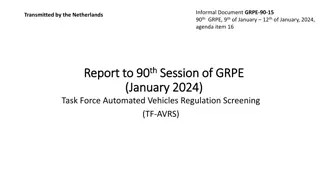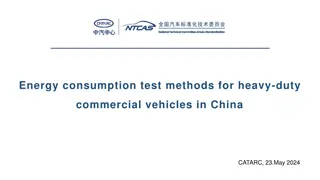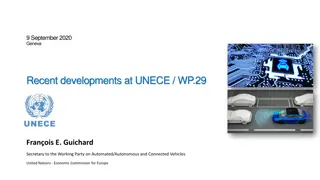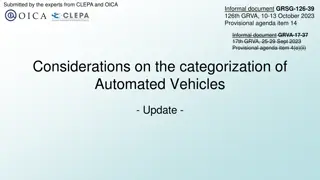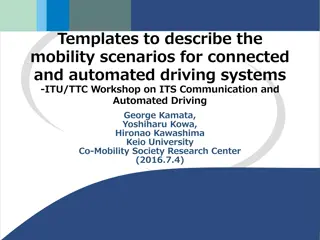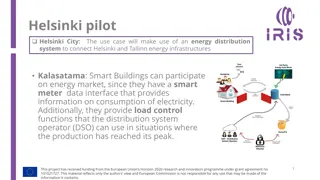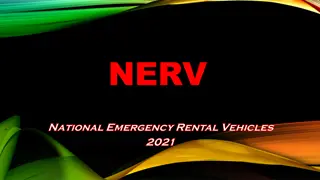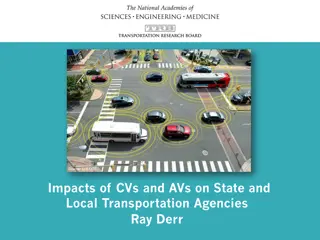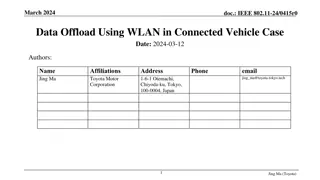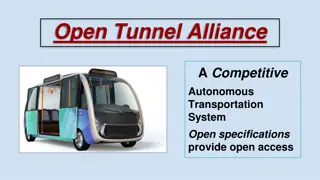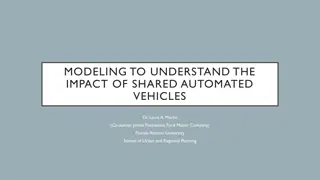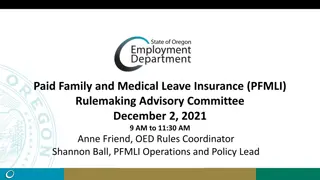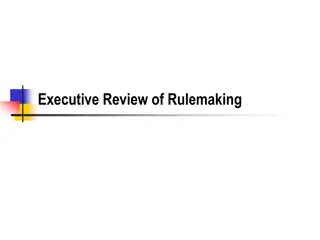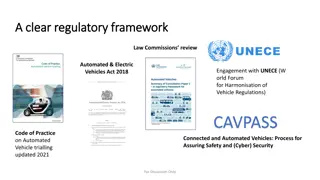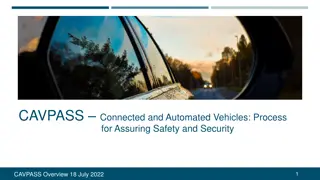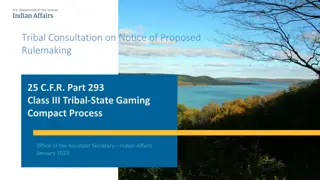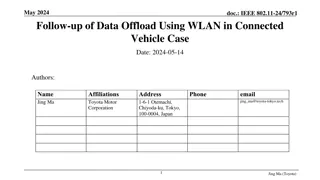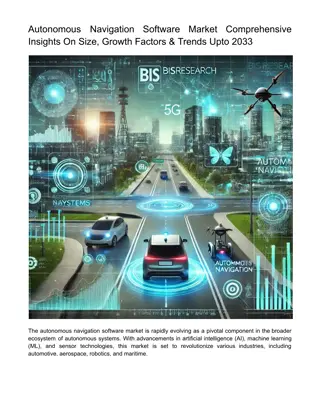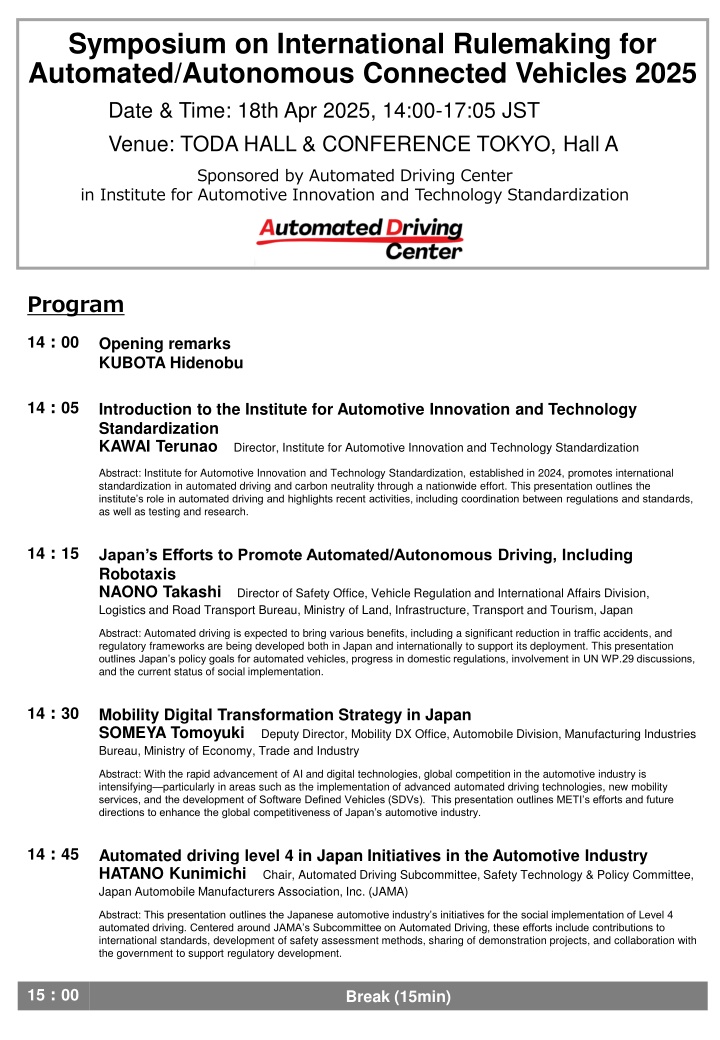
Symposium on International Rulemaking for Automated/Autonomous Vehicles 2025
Explore the Symposium on International Rulemaking for Automated/Autonomous Vehicles 2025 featuring key presentations on Japan's efforts, mobility digital transformation, automated driving initiatives, and regulatory frameworks. Get insights on global competitiveness, robotaxi deployment considerations, and more.
Download Presentation

Please find below an Image/Link to download the presentation.
The content on the website is provided AS IS for your information and personal use only. It may not be sold, licensed, or shared on other websites without obtaining consent from the author. If you encounter any issues during the download, it is possible that the publisher has removed the file from their server.
You are allowed to download the files provided on this website for personal or commercial use, subject to the condition that they are used lawfully. All files are the property of their respective owners.
The content on the website is provided AS IS for your information and personal use only. It may not be sold, licensed, or shared on other websites without obtaining consent from the author.
E N D
Presentation Transcript
Symposium on International Rulemaking for Automated/Autonomous Connected Vehicles 2025 Date & Time: 18th Apr 2025, 14:00-17:05 JST Venue: TODA HALL & CONFERENCE TOKYO, Hall A Sponsored by Automated Driving Center in Institute for Automotive Innovation and Technology Standardization Program 14 00 Opening remarks KUBOTA Hidenobu 14 05 Introduction to the Institute for Automotive Innovation and Technology Standardization KAWAI Terunao Director, Institute for Automotive Innovation and Technology Standardization Abstract: Institute for Automotive Innovation and Technology Standardization, established in 2024, promotes international standardization in automated driving and carbon neutrality through a nationwide effort. This presentation outlines the institute s role in automated driving and highlights recent activities, including coordination between regulations and standards, as well as testing and research. 14 15 Japan s Efforts to Promote Automated/Autonomous Driving, Including Robotaxis NAONO Takashi Director of Safety Office, Vehicle Regulation and International Affairs Division, Logistics and Road Transport Bureau, Ministry of Land, Infrastructure, Transport and Tourism, Japan Abstract: Automated driving is expected to bring various benefits, including a significant reduction in traffic accidents, and regulatory frameworks are being developed both in Japan and internationally to support its deployment. This presentation outlines Japan s policy goals for automated vehicles, progress in domestic regulations, involvement in UN WP.29 discussions, and the current status of social implementation. 14 30 Mobility Digital Transformation Strategy in Japan SOMEYA Tomoyuki Deputy Director, Mobility DX Office, Automobile Division, Manufacturing Industries Bureau, Ministry of Economy, Trade and Industry Abstract: With the rapid advancement of AI and digital technologies, global competition in the automotive industry is intensifying particularly in areas such as the implementation of advanced automated driving technologies, new mobility services, and the development of Software Defined Vehicles (SDVs). This presentation outlines METI s efforts and future directions to enhance the global competitiveness of Japan s automotive industry. 14 45 Automated driving level 4 in Japan Initiatives in the Automotive Industry HATANO Kunimichi Chair, Automated Driving Subcommittee, Safety Technology & Policy Committee, Japan Automobile Manufacturers Association, Inc. (JAMA) Abstract: This presentation outlines the Japanese automotive industry s initiatives for the social implementation of Level 4 automated driving. Centered around JAMA s Subcommittee on Automated Driving, these efforts include contributions to international standards, development of safety assessment methods, sharing of demonstration projects, and collaboration with the government to support regulatory development. 15 00 Break (15min)
A global regulatory framework for Automated Driving Systems Richard DAMM Chair of UN/ECE/WP.29/GRVA, President of Kraftfahrt-Bundesamt, KBA 15 15 Abstract: GRVA is the working group at the UNECE that is coordinating and working on globally harmonized provisions for automated, autonomous and connected vehicles. The presentation gives an overview of the working structure of the WP.29 activities on automated driving and it highlights the recent work of GRVA on an ADS regulatory framework, including Advanced Driver Assistance Systems (ADAS). 15 30 Considerations for Robotaxi Deployment Some Canadian perspectives on North American activities to date Ibrahima SOW Executive Director - Road Safety & Vehicle Regulations, Transport Canada Abstract: This presentation provides an overview of robotaxi deployment in North America, with a particular focus on Canada s regulatory context. It highlights the need for coordinated governance across federal, provincial, and municipal levels. Key considerations include regulatory flexibility, safety assurance, and collaboration with local stakeholders to support safe and scalable deployment of Automated Driving Systems (ADS). 15 45 Status of EU regulatory activities on driving automation and next steps Mohamed BRAHMI European Commission s Directorate-General for Internal Market, Industry, Entrepreneurship and SMEs Abstract: This presentation provides an overview of the current status and future steps of EU regulatory activities on driving automation. It covers the EU type-approval framework for various levels of automated driving systems, the roadmap for cross- border and multi-member state ADS deployment, and the plan for large-scale ADS approval by 2026. 16 00 The Construction and Development of Standard System for Intelligent and Connected Vehicles in China Chen CHEN Technical Manager, China Automotive Technology and Research Center Co., Ltd. Abstract: This presentation introduces the phased development of China's Intelligent and Connected Vehicles (ICV) standard system. The 2023 version adopts a comprehensive technical framework supporting advanced automation and cross-industry integration. It aims to establish a unified and adaptive standard system by 2030, supporting both national innovation and international harmonization, with over 140 relevant standards planned. 16 15 Break (15min) 16 30 Panel discussion (Questions and Answers) 17 00 Closing remarks KAWAI Terunao Director, Institute for Automotive Innovation and Technology Standardization 17 15 Networking event 18 15 Closing
Profile Name: KAWAI Terunao Position: - Managing Director for Research Affairs on Automated Driving Technology, - Director, Automotive Safety Research Department, - Executive Researcher,National Traffic Safety and Environment Laboratory Director of the Institute, Institute for Automotive Innovation and Technology Standardization Director of the Center, Automated Driving Center History of career April, 2012 - Deputy Director, Automotive Safety Research Department, - Director, International Harmonization Promotion Department, - Director, Automotive Research Department, National Traffic Safety and Environment Laboratory April, 2018 Director, Automotive Safety Research Department, National Traffic Safety and Environment Laboratory, National Agency for Automobile and Land Transport Technology April 2022 Managing Director for Research Affairs on Automated Driving Technology 2016 Director, Institute for Automated and Connected Vehicle Standardization Member of Vehicle Safety Measures Study Committee, Ministry of Land, Infrastructure, Transport and Tourism, etc - Temporary member of Advisory Committee for Natural Resources and Energy, Ministry of Economy, Trade and Industry - Member of Panel on Business Strategies in Automated Driving, etc. Name: NAONO Takashi Position: Director of Safety Office, Vehicle Regulation and International Affair Division, Logistics and Road Transport Bureau, Ministry of Land, Infrastructure, Transport and Tourism, Japan Entered into MLIT, Japan (2000) Official, Economic Cooperation Bureau, Ministry of Foreign Affairs, Japan (2004) Senior Inspector, National Technical Safety and Environmental Laboratory (2007) Deputy Director, Technical policy division, Road Transport Bureau, MLIT (2012) Director of JASIC, Geneva (2014) Director of Branch office of MLIT, Kansai Transport Bureau (2018) Current position (2020) Vice-chair of UNECE World Forum for Harmonization of Vehicle Regulations (WP.29) (2023) Name: SOMEYA Tomoyuki Position: Deputy Director, Mobility DX Office, Automobile Division, Manufacturing Industries Bureau, Ministry of Economy, Trade and Industry Joined the Ministry of Economy, Trade and Industry (METI) in 2018. Since joining the ministry, he has been engaged in policy development in the fields of digital technology and emerging industries, including initiatives related to 5G, the establishment of the Digital Agency, and the promotion of the bio-industry. He has been serving in his current position since January 2025. Name: Kunimichi HATANO Position: Exective Chief Engineer, Software Defined Mobility Development Supervisroy Unit, Business Development Operations, Honda Motor Co., Ltd. 1990 Honda R&D Co., Ltd. 1999 Started brake-by-wire research 2009 Started development of "Electric Servo Brake System" 2013 Started research and development of Automated Driving System 2015 65th JSAE Award, The Technological Development Award for "Development of Electric Servo Brake System" 2020 Received type approval for the world's first level 3 automated driving system at Honda Legend 2021 Chairman of JAMA Autonomous Driving Subcommittee 2022 Honda Motor Co., Ltd. Business Development Operations Richard Damm is President of the Federal Motor Transport Authority (Kraftfahrt-Bundesamt - KBA). He is also Chairman of the UNECE GRVA Working Group on Automated, Autonomous and Connected Vehicles in Geneva, in which the globally applicable regulations on the automation of vehicles are developed. Prior to his appointment as President of the KBA, Mr Damm worked at the Federal Ministry of Transport and Digital Infrastructure in Bonn and Berlin. Mr Damm is an internationally recognised expert in the field of global harmonisation of vehicle regulations. His current focus is on automation, networking and digitalisation at national and international level. He graduated from the Technical University of Munich as mechanical engineer in automotive engineering and product development.
Mr. Ibrahima Sow is the Executive Director of Transport Canadas Road Safety and Vehicle Regulations branch where he supports the development and implementation of the federal legislative and policy framework governing road safety & motor vehicle safety in Canada. In his role, Mr. Sow oversees the development of national safety requirements to address the safe testing and deployment of connected and automated vehicle safety in Canada (including national testing guidelines and a national safety assessment tool for automated driving systems, among other initiatives). He currently serves as Canada s representative to the UNECE Global Forum for Road Traffic Safety (WP.1) and the World Forum for Harmonization of Vehicle Regulations (WP.29). Since its inception, Ibrahima also serves as co-chair of the UNECE informal working group on the safety of Automated Driving Systems (ADS) which supports the work of WP.29/GRVA and is mandated to develop UN Regulation under the 1958 Agreement and UN Global Technical Regulation (GTR) for ADS safety. Ibrahima is also accountable for overseeing Consumer & Public Awareness, Collision Investigations, Evaluation and Data Systems (National Collision Database), Road Users Safety (distraction, impairment, vulnerable road users), Human Factors and Crash Avoidance Research & Testing, Standards and Regulations, Motor Carrier safety (e.g. hours of service) and stakeholder engagement (Provincial/Territorial & International). Mr. Sow holds both a bachelor s degree and a master s degree in mechanical engineering with a specialization in Characterization of materials / Non-Destructive testing of Composite and Viscoelastic Materials. Dr.-Ing Mohamed Brahmi works on regulations for automated and connected driving at the European Commission and lectures on automated driving and ADAS at Hochschule M nchen since 2024. History of career Developed L3 autonomous driving validation methods at BMW Group (2000) led radar system base development at Continental (2019). Worked at Continental Japan Yokohama for 3 years in the field of ADAS as Expat (2016). Worked at Continental on radar-based ADAS in Lindau, Germany (2014). Holds a Dr.-Ing. from Technische Universit t Braunschweig and a Dipl.-Ing. from Technische Universit t M nchen. Chen Chen, Technical manager, China Automotive Technology and Research Center Co., Ltd. Responsible for technical research on driving scenario and simulation application in intelligent and connected vehicle area and deeply participated in the standardization process of national standards for ICV. Project leader of ISO 34505 Road vehicles Test scenarios for automated driving systems Scenario evaluation and test case generation , registered expert in ISO TC22 SC33 WG9 test scenario of automated driving systems working group and ISO TC22 SC31 WG9 sensor data interface for automated driving functions working group. The presentation materials are available at the following link: Please give us your feedback. https://forms.office.com/r/3ECBpZXd0r https://www.jasic.org/ACV/ Secretariat: Japan Automobile Standards Internationalization Center Japan Automobile Transport Technology Association 7F, Zennihon Truck Sogo Kaikan., 3-2-5 Yotsuya, Shinjuku-ku, Tokyo 160-0004, JAPAN TEL: 03-5362-7751 E-mail: jasic@jasic.org URL: http://www.jasic.org/

